Renewable Energy Use for Conversion of Residential House into an Off-Grid Building—Case Study
Abstract
1. Introduction
2. Materials and Methods
- Variant 1–off-grid building heated by a heat pump and powered by a PV system and a wind power system;
- Variant 2–off-grid building heated by a modern solid biomass (pellets) boiler and a heat pump, powered by a PV system and a wind power system;
- Variant 3–off-grid building heated by a modern solid biomass (pellets) boiler and a heat pump, powered by a PV system and a wind power system as well as a power generator.
2.1. Variant 1–Off-Grid Building Heated by a Heat Pump
- Epvp is the calculated PV energy production (for each hour of the year) [kWh];
- Epvc is the PV energy production in the existing state (for each hour of the year) [kWh];
- Ppvc is the power of the PV system in the existing state [kW];
- Ppvp is the planned power of the PV system [kW].
- Ewt is the calculated energy production from the wind system (for each hour of the year) [kWh];
- a is the wind turbine power at a given wind speed [kW].
- EB is the energy balance (for each hour of the year) [kWh];
- Epvp is the calculated PV energy production (for each hour of the year) [kWh];
- Ewt is the calculated energy production from the wind system (for each hour of the year) [kWh];
- EC is the energy consumption (for each hour of the year) [kWh].
- ES is the amount of energy in the battery (for each hour of the year) [kWh];
- EB is the energy balance (for each hour of the year) [kWh];
- SC is the battery capacity (for each hour of the year) [kWh].
- S is the state of charge of the batteries (for each hour of the year) [%];
- ES is the amount of energy in the battery (for each hour of the year) [kWh].
2.2. Variant 2–Off-Grid Building Heated by a Solid Biomass (Pellets) Boiler and a Heat Pump
- Ebbi is the energy that needs to be supplied by the biomass boiler in the ith hour of the heating season [kWh];
- EC’I is the electricity consumption for heating purposes in the ith hour of the year [kWh];
- SCOP is the Seasonal Coefficient of Performance of the heat pump used [-].
- FCbb is the amount of fuel consumed by the solid biomass boiler during the heating season [kg];
- Ebb is the total amount of energy that needs to be generated by the biomass boiler during the heating season [MJ];
- ηbb is the efficiency of the biomass boiler [-];
- HVb is the calorific value of the fuel [MJ/kg].
2.3. Variant 3–Off-Grid Building Heated by a Solid Biomass (Pellets) Boiler and a Heat Pump
- FCpg is the amount of fuel used to power the generator for one year [L];
- Epg is the total amount of electricity that needs to be produced by the generator [kWh];
- ηpg is the efficiency of the generator [-];
- HVpg is the calorific value of the fuel [kWh/litre].
2.4. Calculation of Electricity Production from the Wind System
3. Results and Discussion
3.1. Variant 1
3.2. Variant 2
3.3. Variant 3
3.4. Economic Analysis
4. Conclusions and Remarks
Author Contributions
Funding
Data Availability Statement
Conflicts of Interest
References
- European Parliament Resolution of 28 November 2019 on the Climate and Environment Emergency (2019/2930(RSP)). Available online: https://eur-lex.europa.eu/legal-content/EN/TXT/?uri=CELEX%3A52019IP0078%2801%29 (accessed on 10 December 2024).
- Regulation (EU) 2021/1119 of the European Parliament and of the Council of 30 June 2021 Establishing the Framework for Achieving Climate Neutrality and Amending Regulations (EC) No 401/2009 and (EU) 2018/1999 (‘European Climate Law’). L243/1. Available online: https://eur-lex.europa.eu/legal-content/EN/TXT/?uri=CELEX:32021R1119 (accessed on 10 December 2024).
- Directive (EU) 2023/1791 of the European Parliament and of the Council of 13 September 2023 on Energy Efficiency and Amending Regulation (EU) 2023/955 (Recast) (Text with EEA Relevance). L 231/1. Available online: https://eur-lex.europa.eu/legal-content/EN/TXT/?uri=CELEX:32023L1791 (accessed on 12 December 2024).
- Yoon, S.; Lee, J. Perspective for waste upcycling-driven zero energy buildings. Energy 2024, 289, 130029. [Google Scholar] [CrossRef]
- Notice of the Minister of Climate and Environment of March 2, 2021 on the State Energy Policy Until 2040 (Item 264). Available online: https://isap.sejm.gov.pl/isap.nsf/download.xsp/WMP20210000264/O/M20210264.pdf (accessed on 20 January 2025). (In Polish)
- Statistics Poland. Energy; Statistics Poland: Rzeszów, Poland, 2023. Available online: https://stat.gov.pl/download/gfx/portalinformacyjny/pl/defaultaktualnosci/5485/1/11/1/energia_2023.pdf (accessed on 20 January 2025).
- Biernat-Jarka, A.; Trębska, P.; Jarka, S. The role of renewable energy sources in alleviating energy poverty in households in Poland. Energies 2021, 14, 2957. [Google Scholar] [CrossRef]
- Statistics Poland. Energy from Renewable Sources in 2022; Statistical Analyses; Statistics Poland: Warszawa, Poland; Rzeszów, Poland, 2023. [Google Scholar]
- Giesekam, J.; Tingley, D.D.; Cotton, I. Aligning carbon targets for construction with (inter) national climate change mitigation commitments. Energy Build. 2018, 165, 106–117. [Google Scholar] [CrossRef]
- Mercader-Moyano, P.; Esquivias, P.M. Decarbonization and circular economy in the sustainable development and renovation of buildings and neighbourhoods. Sustainability 2020, 12, 7914. [Google Scholar] [CrossRef]
- Zhang, Y.; Hu, S.; Guo, F.; Mastrucci, A.; Zhang, S.; Yang, Z.; Yan, D. Assessing the potential of decarbonizing China’s building construction by 2060 and synergy with industry sector. J. Clean. Prod. 2022, 359, 132086. [Google Scholar] [CrossRef]
- Arogundade, S.; Dulaimi, M.; Ajayi, S.; Saka, A.; Ilori, O. Decarbonization of construction projects: A review and interpretive structural modelling of carbon reduction drivers. J. Eng. Des. Technol. 2023. [Google Scholar] [CrossRef]
- Sbahieh, S.; Serdar, M.Z.; Al-Ghamdi, S.G. Decarbonization strategies of building materials used in the construction industry. Mater. Today Proc. 2023, 1–6. [Google Scholar] [CrossRef]
- Hossain, M.A.; Nadeem, A. Towards digitizing the construction industry: State of the art of construction 4.0. In Proceedings of the ISEC 2019, Chicago, IL, USA, 20–25 May 2019; ISEC Press: Fargo, ND, USA, 2019; Volume 10, pp. 1–6. [Google Scholar]
- Goger, G.; Bisenberger, T. Digitalization in infrastructure construction–Developments in construction operations. Geomech. Tunn. 2020, 13, 165–177. [Google Scholar] [CrossRef]
- Rahman, A.U.; Alam, S.M.; Dallasega, P.; Marengo, E.; Nutt, W. Increasing Control in Construction Processes: The Role of Digitalization. In Business Process Management Workshops, Proceedings of the BPM 2020 International Workshops, Seville, Spain, 13–18 September 2020; Revised Selected Papers 18; Springer International Publishing: Cham, Switzerland, 2020; pp. 263–275. [Google Scholar]
- Sezer, A.A.; Thunberg, M.; Wernicke, B. Digitalization index: Developing a model for assessing the degree of digitalization of construction projects. J. Constr. Eng. Manag. 2021, 147, 04021119. [Google Scholar] [CrossRef]
- Nikmehr, B.; Hosseini, M.R.; Martek, I.; Zavadskas, E.K.; Antucheviciene, J. Digitalization as a strategic means of achieving sustainable efficiencies in construction management: A critical review. Sustainability 2021, 13, 5040. [Google Scholar] [CrossRef]
- Adamuscin, A.; Golej, J.; Panik, M. The challenge for the development of Smart City Concept in Bratislava based on examples of smart cities of Vienna and Amsterdam. EAI Endorsed Trans. Smart Cities 2016, 1, e5. [Google Scholar] [CrossRef]
- Jopek, D. Intelligent urban space as a factor in the development of smart cities. Tech. Trans. 2019, 116, 5–15. [Google Scholar] [CrossRef]
- Apanaviciene, R.; Vanagas, A.; Fokaides, P.A. Smart building integration into a smart city (SBISC): Development of a new evaluation framework. Energies 2020, 13, 2190. [Google Scholar] [CrossRef]
- Froufe, M.M.; Chinelli, C.K.; Guedes, A.L.A.; Haddad, A.N.; Hammad, A.W.; Soares, C.A.P. Smart buildings: Systems and drivers. Buildings 2020, 10, 153. [Google Scholar] [CrossRef]
- Li, Y.W.; Cao, K. Establishment and application of intelligent city building information model based on BP neural network model. Comput. Commun. 2020, 153, 382–389. [Google Scholar] [CrossRef]
- Hałaj, E.; Kotyza, J.; Hajto, M.; Pełka, G.; Luboń, W.; Jastrzębski, P. Upgrading a District Heating System by Means of the Integration of Modular Heat Pumps, Geothermal Waters, and PVs for Resilient and Sustainable Urban Energy. Energies 2021, 14, 2347. [Google Scholar] [CrossRef]
- Komninos, N.; Kakderi, C.; Mora, L.; Panori, A.; Sefertzi, E. Towards high impact smart cities: A universal architecture based on connected intelligence spaces. J. Knowl. Econ. 2022, 13, 1169–1197. [Google Scholar] [CrossRef]
- Al Dakheel, J.; Del Pero, C.; Aste, N.; Leonforte, F. Smart buildings features and key performance indicators: A review. Sustain. Cities Soc. 2020, 61, 102328. [Google Scholar] [CrossRef]
- Economidou, M.; Todeschi, V.; Bertoldi, P.; D’Agostino, D.; Zangheri, P.; Castellazzi, L. Review of 50 years of EU energy efficiency policies for buildings. Energy Build. 2020, 225, 110322. [Google Scholar] [CrossRef]
- Fokaides, P.A.; Apanaviciene, R.; Černeckiene, J.; Jurelionis, A.; Klumbyte, E.; Kriauciunaite-Neklejonoviene, V.; Pupeikis, D.; Rekus, D.; Sadauskiene, J.; Seduikyte, L.; et al. Research challenges and advancements in the field of sustainable energy technologies in the built environment. Sustainability 2020, 12, 8417. [Google Scholar] [CrossRef]
- Myers, D. Construction Economics: A New Approach, 5th ed.; Routledge: London, UK, 2022. [Google Scholar] [CrossRef]
- Sartori, I.; Napolitano, A.; Voss, K. Net zero energy buildings: A consistent definition framework. Energy Build. 2012, 48, 220–232. [Google Scholar] [CrossRef]
- Chel, A.; Kaushik, G. Renewable energy technologies for sustainable development of energy efficient building. Alex. Eng. J. 2018, 57, 655–669. [Google Scholar] [CrossRef]
- Cuce, E.; Nachan, Z.; Cuce, P.M.; Sher, F.; Neighbour, G.B. Strategies for ideal indoor environments towards low/zero carbon buildings through a biomimetic approach. Int. J. Ambient. Energy 2019, 40, 86–95. [Google Scholar] [CrossRef]
- Omer, A.M. Design and operation of low energy consumption passive human comfort solutions. J. Commer. Manag. Thought 2020, 11, 40–62. [Google Scholar] [CrossRef]
- Wang, Y.; Hu, B.; Meng, X.; Xiao, R. A Comprehensive Review on Technologies for Achieving Zero-Energy Buildings. Sustainability 2024, 16, 10941. [Google Scholar] [CrossRef]
- Baghdadi, A.; Abuhussain, M. In-Depth Analysis of Photovoltaic-Integrated Shading Systems’ Performance in Residential Buildings: A Prospective of Numerical Techniques Toward Net-Zero Energy Buildings. Buildings 2025, 15, 222. [Google Scholar] [CrossRef]
- Mohammadi, S. Energy autonomous buildings: A review. In Proceedings of the 7th International Energy Conference, Kuwait City, Kuwait, 18–21 November 2019; Available online: https://www.proquest.com/docview/2501937301 (accessed on 16 December 2024).
- Taherahmadi, J.; Noorollahi, Y.; Panahi, M. Toward comprehensive zero energy building definitions: A literature review and recommendations. Int. J. Sustain. Energy 2021, 40, 120–148. [Google Scholar] [CrossRef]
- Grazieschi, G.; Gori, P.; Lombardi, L.; Asdrubali, F. Life cycle energy minimization of autonomous buildings. J. Build. Eng. 2020, 30, 101229. [Google Scholar] [CrossRef]
- Chen, S.Y.; Chu, C.Y.; Cheng, M.J.; Lin, C.Y. The autonomous house: A bio-hydrogen based energy self-sufficient approach. Int. J. Environ. Res. Public Health 2009, 6, 1515–1529. [Google Scholar] [CrossRef] [PubMed]
- Hemmati, R. Stochastic energy investment in off-grid renewable energy hub for autonomous building. IET Renew. Power Gener. 2019, 13, 2232–2239. [Google Scholar] [CrossRef]
- Farzaneh, H.; Malehmirchegini, L.; Bejan, A.; Afolabi, T.; Mulumba, A.; Daka, P.P. Artificial intelligence evolution in smart buildings for energy efficiency. Appl. Sci. 2021, 11, 763. [Google Scholar] [CrossRef]
- Karami, M.; Harvey, T. Autonomous Buildings Enable Energy Efficiency. ASHRAE Trans. 2022, 128, 208–216. [Google Scholar]
- Liu, Z.; Zhang, X.; Sun, Y.; Zhou, Y. Advanced controls on energy reliability, flexibility and occupant-centric control for smart and energy-efficient buildings. Energy Build. 2023, 297, 113436. [Google Scholar] [CrossRef]
- Khedher, N.B.; Mukhtar, A.; Md Yasir, A.S.H.; Khalilpoor, N.; Foong, L.K.; Nguyen Le, B.; Yildizhan, H. Approximating heat loss in smart buildings through large scale experimental and computational intelligence solutions. Eng. Appl. Comput. Fluid Mech. 2023, 17, 2226725. [Google Scholar] [CrossRef]
- Alsharifi, T.; Mahdi, J.M.; Togun, H.; Al-Najjar, H.M.T.; Khedher, N.B.; Cairns, A.; Talebizadehsardari, P. Design and optimization of a household photovoltaic/thermal collector with serpentine tube: Energy and exergy analysis. Appl. Therm. Eng. 2024, 246, 122983. [Google Scholar] [CrossRef]
- Jaysawal, R.K.; Chakraborty, S.; Elangovan, D.; Padmanaban, S. Concept of net zero energy buildings (NZEB)—A literature review. Clean. Eng. Technol. 2022, 11, 100582. [Google Scholar] [CrossRef]
- Franchini, G.; Brumana, G.; Perdichizzi, A. Monitored performance of the first energy+ autonomous building in Dubai. Energy Build. 2019, 205, 109545. [Google Scholar] [CrossRef]
- Luboń, W.; Pełka, G.; Marszałek, K.; Małek, A. Performance analysis of crystalline silicon and CIGS photovoltaic modules in outdoor measurement. Ecol. Chem. Eng. S 2017, 24, 539–549. [Google Scholar] [CrossRef][Green Version]
- Teixeira, G.P.L. Energy Autonomous Buildings-Housing Project; Faculdade de Engenharia da Universidade do Porto: Porto, Portugal, 2021; Available online: https://repositorio-aberto.up.pt/bitstream/10216/135091/2/485022.pdf (accessed on 14 December 2024).
- Fedak, W.; Anweiler, S.; Ulbrich, R.; Jarosz, B. The concept of autonomous power supply system fed with renewable energy sources. J. Sustain. Dev. Energy Water Environ. Syst. 2017, 5, 579–589. [Google Scholar] [CrossRef]
- Titkov, V.V.; Bekbayev, A.B.; Munsyzbai, T.M.; Shakenov, K.B. Construction of autonomous buildings with wind power plants. Mag. Civ. Eng. 2018, 4, 171–180. [Google Scholar]
- Akram, U.; Khalid, M.; Shafiq, S. An improved optimal sizing methodology for future autonomous residential smart power systems. IEEE Access 2018, 6, 5986–6000. Available online: https://ieeexplore.ieee.org/document/8255587 (accessed on 20 December 2024). [CrossRef]
- Zicmane, I.; Berzina, K.; Lomane, T.; Kasperjuks, K. Improving the energy efficiency of an autonomous power system with renewable sources. In Proceedings of the 2018 International Conference on Intelligent and Innovative Computing Applications (ICONIC), Mon Tresor, Mauritius, 6–7 December 2018; IEEE: Piscataway, NJ, USA, 2018; pp. 1–6. Available online: https://ieeexplore.ieee.org/abstract/document/8601288 (accessed on 20 December 2024).
- Chauhan, R.K.; Chauhan, K.; Subrahmanyam, B.R.; Singh, A.G.; Garg, M.M. Distributed and centralized autonomous DC microgrid for residential buildings: A case study. J. Build. Eng. 2020, 27, 100978. [Google Scholar] [CrossRef]
- Tazay, A.F.; Samy, M.M.; Barakat, S. A techno-economic feasibility analysis of an autonomous hybrid renewable energy sources for university building at Saudi Arabia. J. Electr. Eng. Technol. 2020, 15, 2519–2527. Available online: https://link.springer.com/article/10.1007/s42835-020-00539-x (accessed on 20 December 2024). [CrossRef]
- Knosala, K.; Kotzur, L.; Röben, F.T.; Stenzel, P.; Blum, L.; Robinius, M.; Stolten, D. Hybrid hydrogen home storage for decentralized energy autonomy. Int. J. Hydrogen Energy. 2021, 46, 21748–21763. [Google Scholar] [CrossRef]
- Kumar, G.M.S.; Cao, S. State-of-the-art review of positive energy building and community systems. Energies 2021, 14, 5046. [Google Scholar] [CrossRef]
- Cardoso, J.; Leal, V.; Azevedo, I.; Silva, M.C. Designing carbon neutral, net-zero, nearly-zero and positive energy districts or neighbourhoods: Current approaches and solutions. Adv. Build. Energy Res. 2024, 18, 602–640. [Google Scholar] [CrossRef]
- Barwińska-Małajowicz, A.; Banaś, M.; Piecuch, T.; Pyrek, R.; Szczotka, K.; Szymiczek, J. Energy and Ecological Concept of a Zero-Emission Building Using Renewable Energy Sources—Case Study in Poland. Energies 2024, 17, 5817. [Google Scholar] [CrossRef]
- Szymańska, E.J.; Kubacka, M.; Woźniak, J.; Polaszczyk, J. Analysis of residential buildings in Poland for potential energy renovation toward zero-emission construction. Energies 2022, 15, 9327. [Google Scholar] [CrossRef]
- Kolokotsa, D.E.K.D.; Rovas, D.; Kosmatopoulos, E.A.; Kalaitzakis, K. A roadmap towards intelligent net zero-and positive-energy buildings. Sol. Energy 2011, 85, 3067–3084. [Google Scholar] [CrossRef]
- Wronowski, M. Conceptual design of plus energy single family house in Warsaw, Poland. REHVA J. 2013, 50, 58–62. [Google Scholar]
- Ala-Juusela, M.; Crosbie, T.; Hukkalainen, M. Defining and operationalising the concept of an energy positive neighbourhood. Energy Conv. Manag. 2016, 125, 133–140. [Google Scholar] [CrossRef]
- Lavikka, R.; Rehman, H.U.; Reda, F.; Kazi, A.S. Positive Energy Buildings. Concepts, Challenges and Opportunities; Springer International Publishing: Cham, Switzerland, 2022. [Google Scholar]
- Barrutieta, X.; Gainza, J.; Irulegi, O.; Hernández, R. The zero building: An exemplary nearly zero energy office building (NZEB) and its potential to become a positive energy building (PEB). Archit. Sci. Rev. 2023, 66, 214–225. [Google Scholar] [CrossRef]
- Hawila, A.A.W.; Pernetti, R.; Pozza, C.; Belleri, A. Plus energy building: Operational definition and assessment. Energy Build. 2022, 265, 112069. [Google Scholar] [CrossRef]
- Data for Energy Calculations of Buildings. Available online: https://www.gov.pl/web/archiwum-inwestycje-rozwoj/dane-do-obliczen-energetycznych-budynkow (accessed on 10 December 2022).
- EN 303-5:2012; Heating Boilers—Part 5: Heating Boilers for Solid Fuels, Manually and Automatically Stoked, Nominal Heat Output of up to 500 kW—Terminology, Requirements, Testing and Marking. European Committee for Standardization: Brussels, Belgium, 2012.
- Pełka, G.; Jach-Nocoń, M.; Paprocki, M.; Jachomowski, A.; Luboń, W.; Nocoń, A.; Wygoda, M.; Wyczesany, P.; Pachytel, P.; Mirowski, T. Comparison of Emissions and Efficiency of Two Types of Burners When Burning Wood Pellets from Different Suppliers. Energies 2023, 16, 1695. [Google Scholar] [CrossRef]
- KOBiZE. Wskaźniki emisji zanieczyszczeń ze spalania paliw dla źródeł o nominalnej mocy cieplnej do 5 MW, zastosowane do automatycznego wyliczenia emisji w raporcie do Krajowej bazy za rok 2022; KOBiZE: Warszawa, Poland, 2023. (In Polish) [Google Scholar]
- MacKay, R.S. Sustainable energy storage–with hot air, or cold air or liquid air. Contemp. Phys. 2020, 61, 1–11. [Google Scholar] [CrossRef]
- Available online: https://www.enair.es/es/aerogeneradores/e200l (accessed on 10 December 2022).
- Available online: https://www.enair.es/es/aerogeneradores/e30pro (accessed on 12 January 2023).
- Available online: https://kratki.com/pl/blog/cena-pomp-ciepla (accessed on 5 April 2025).
- Available online: https://www.kolektory.com/instalacje-fotowoltaiczne-ceny/instalacje-fotowoltaiczne-ceny.html (accessed on 5 April 2025).
- Available online: https://www.kolektory.com/magazyny-energii/zestaw-pv-o-mocy-10-kw-z-akumulatorami.html (accessed on 5 April 2025).
- Available online: https://kobo-energy.pl/przydomowa-elektrownia-wiatrowa-jak-dziala-jakie-sa-koszty-i-komu-sie-oplaca/ (accessed on 5 April 2025).
- Available online: https://termikabieniek.pl/kategoria-produktu/technika-grzewcza/kotly/kotly-na-pellet/ (accessed on 5 April 2025).
- Available online: https://agregaty.sklep.pl/agregat-pradotworczy-barracuda-9500-3f-silent-ats-p-26899.html (accessed on 5 April 2025).
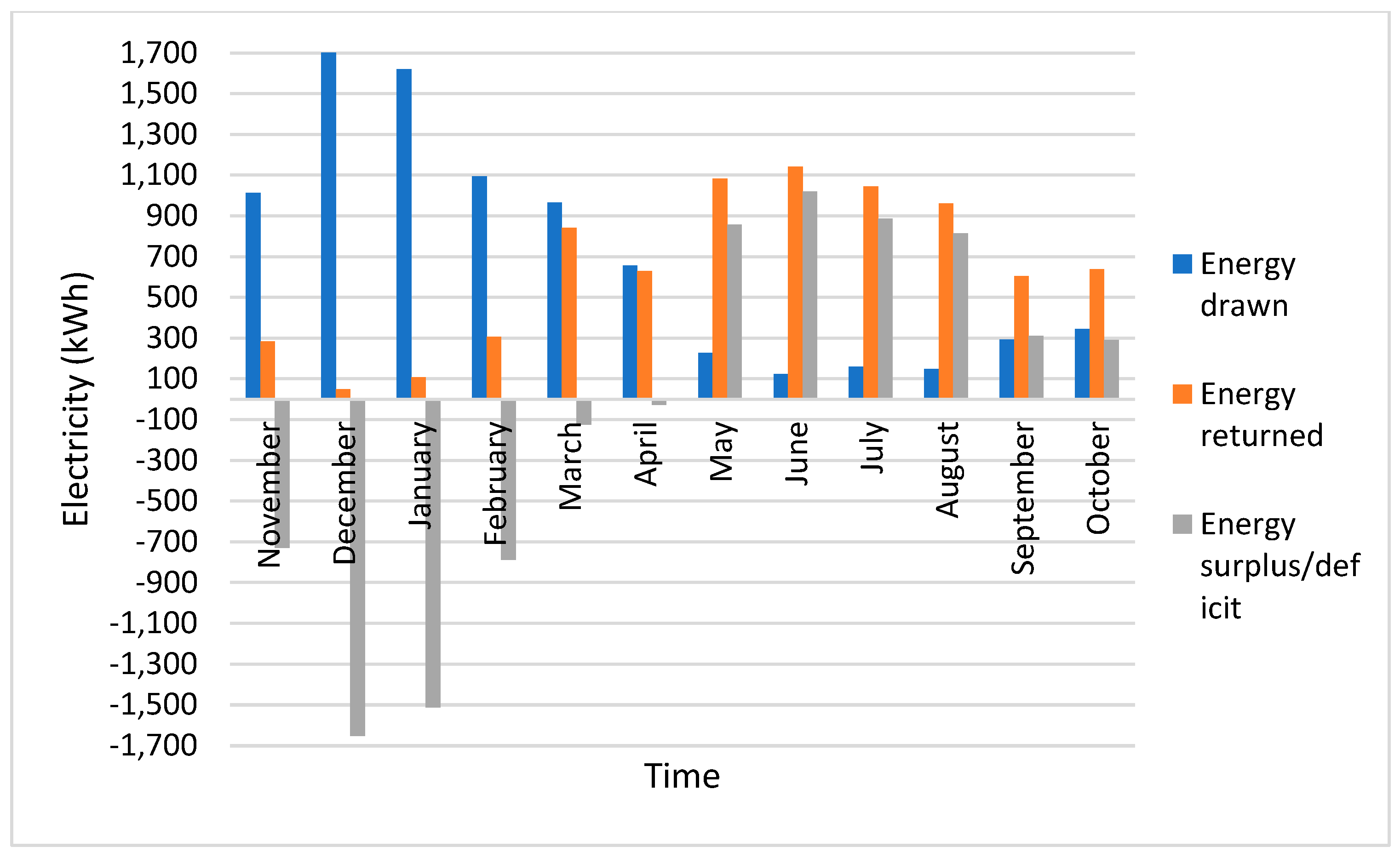

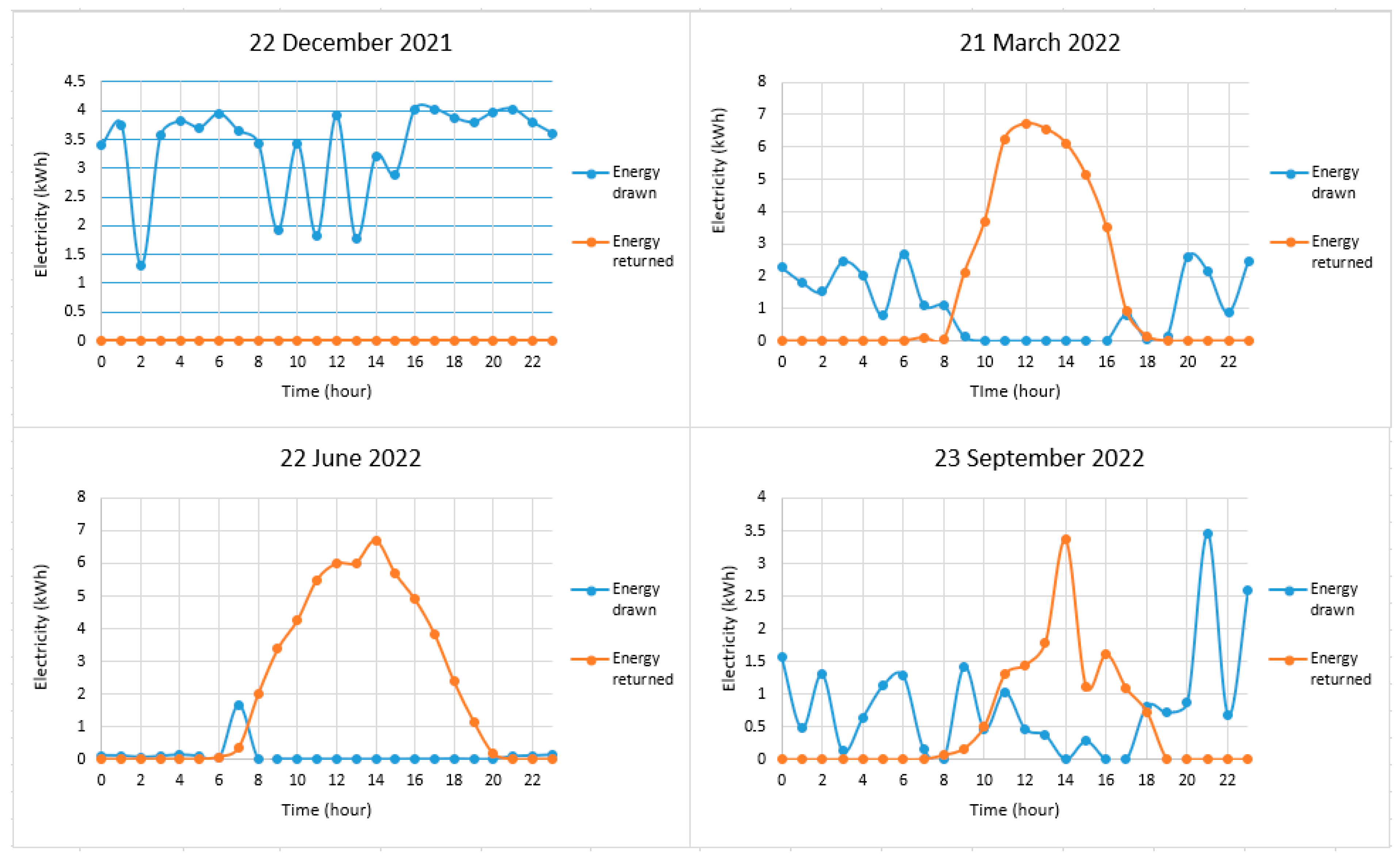
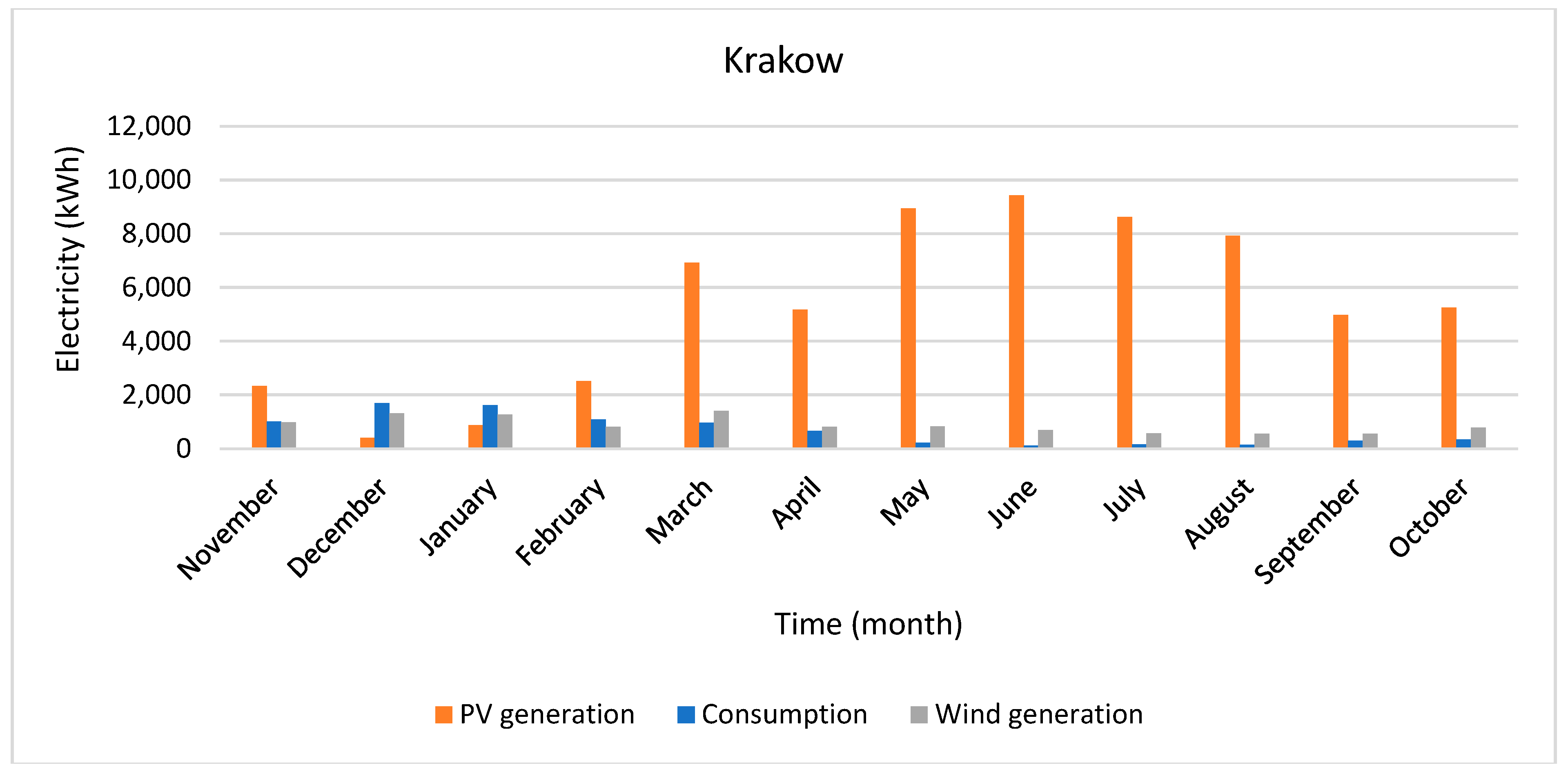
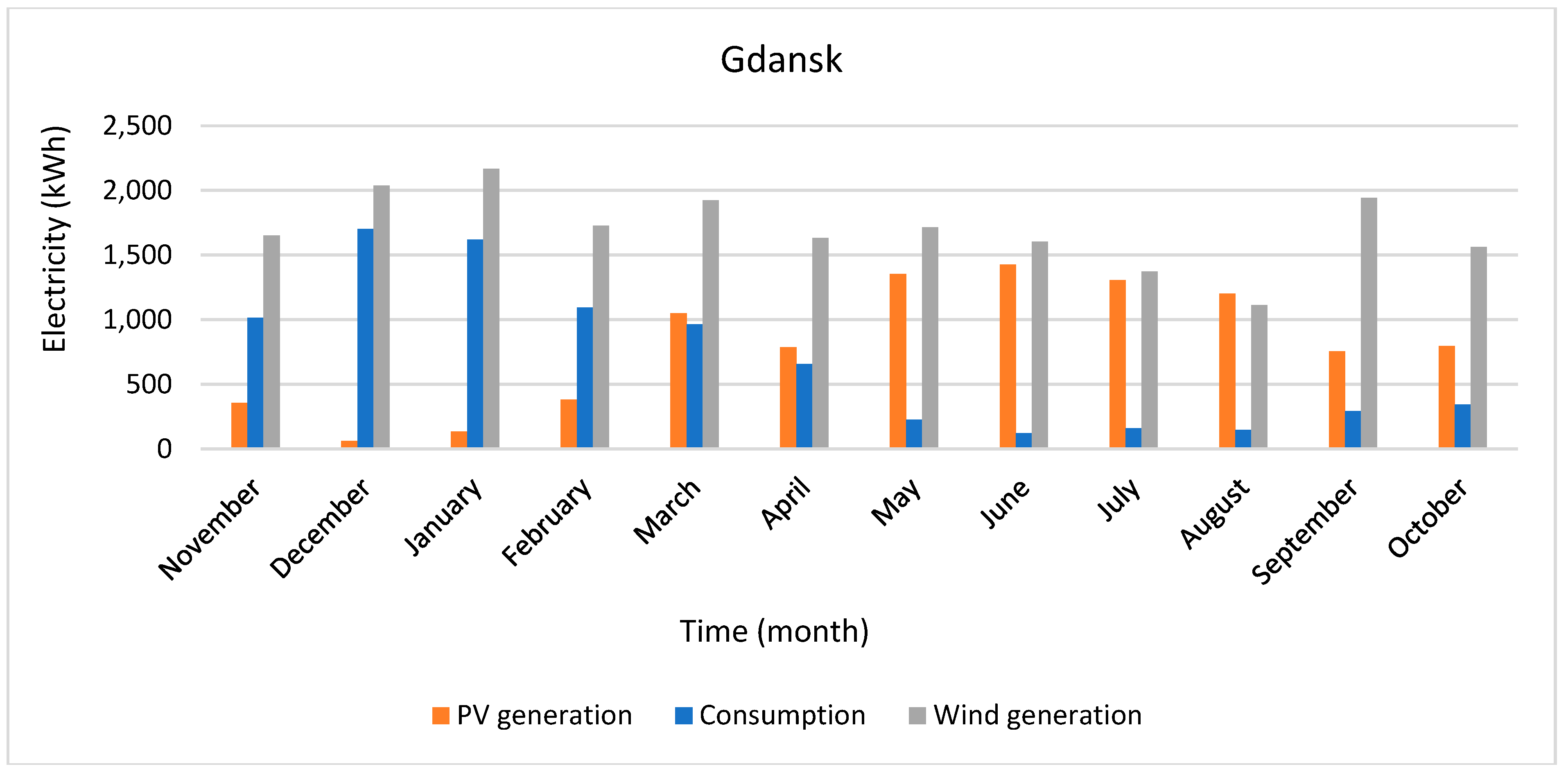

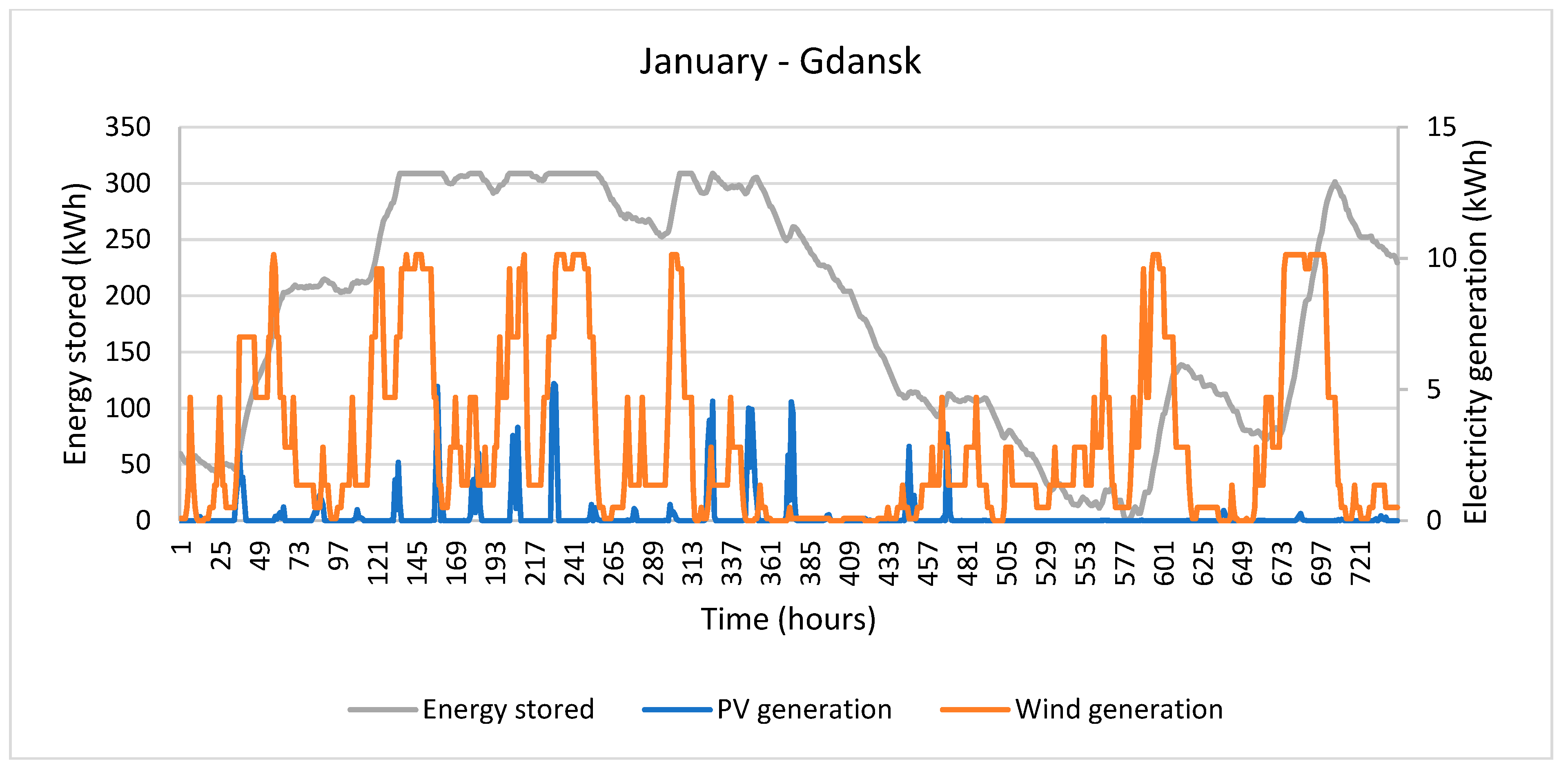

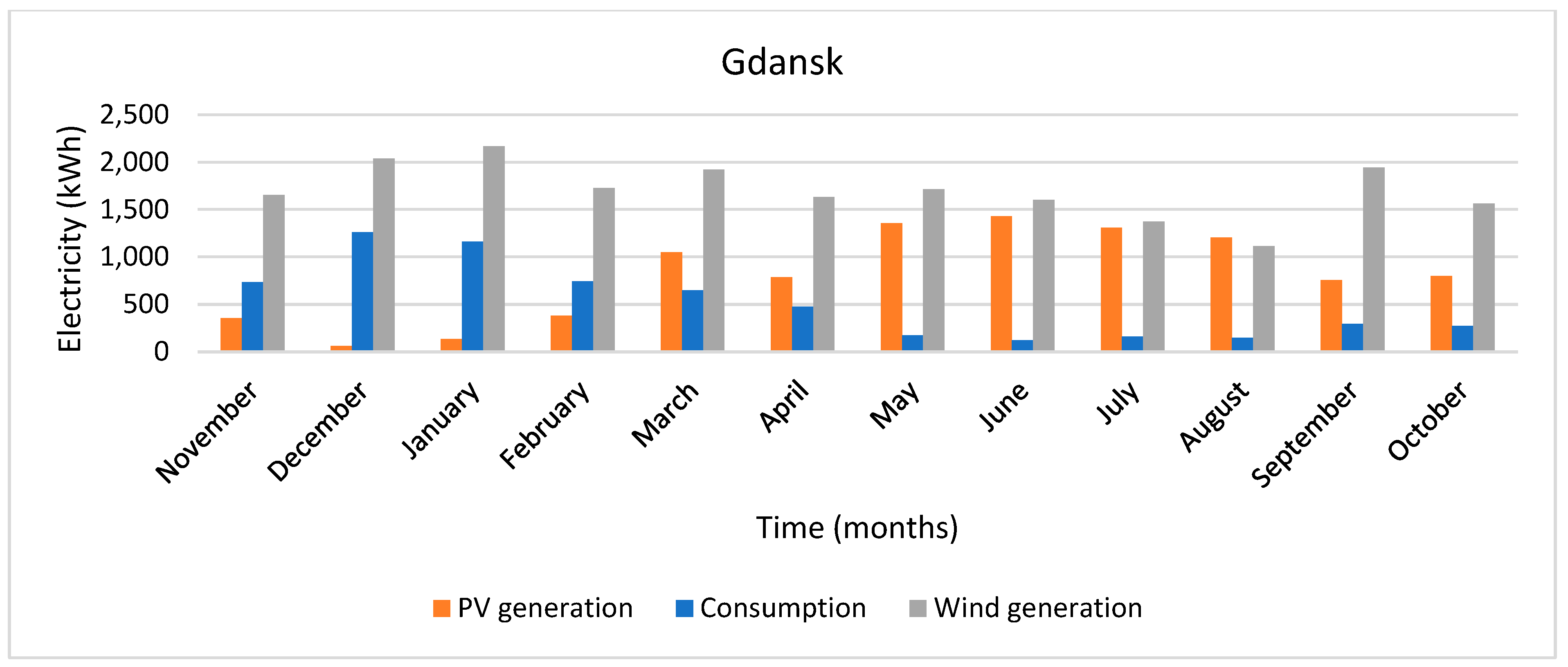
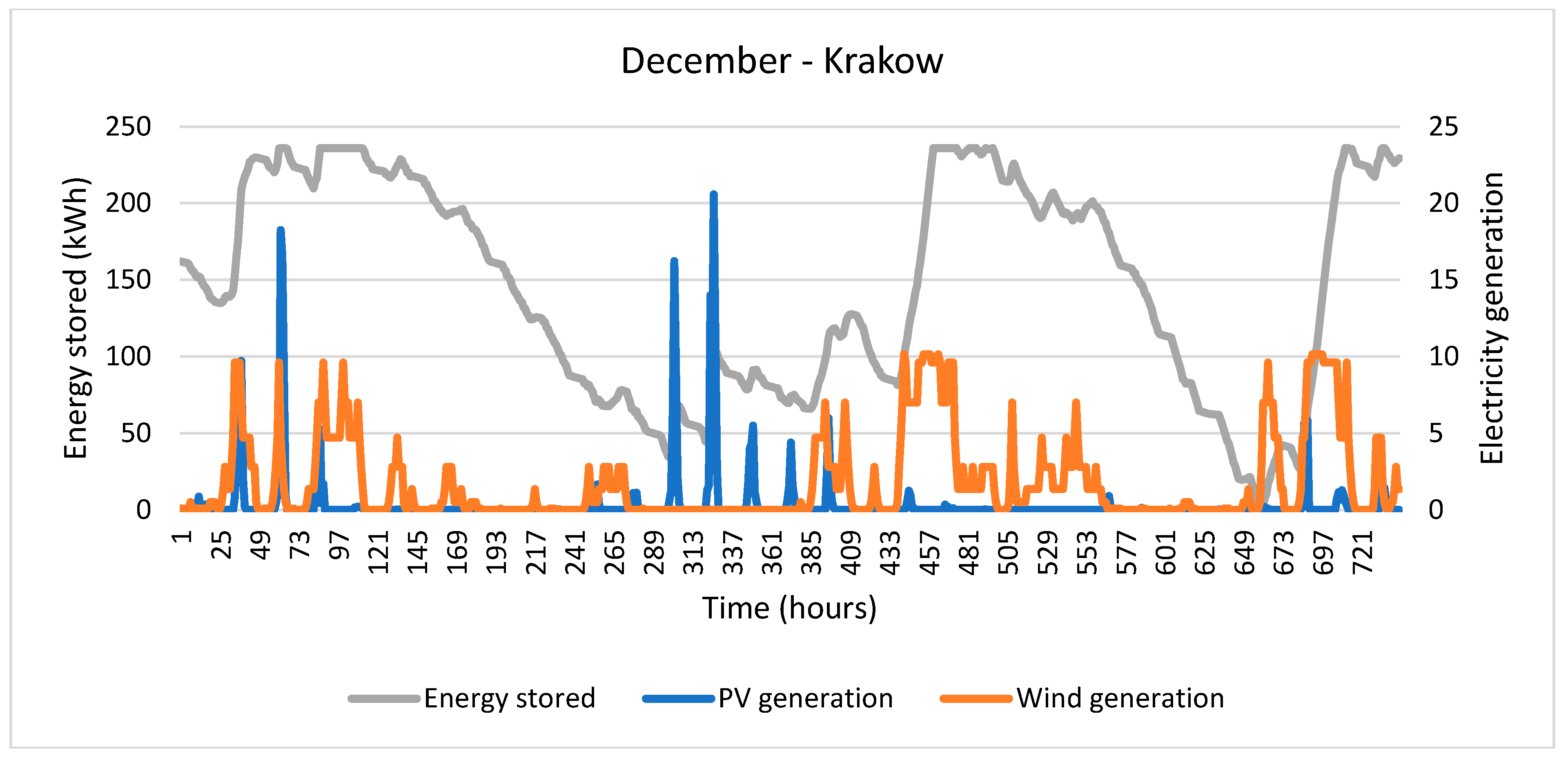
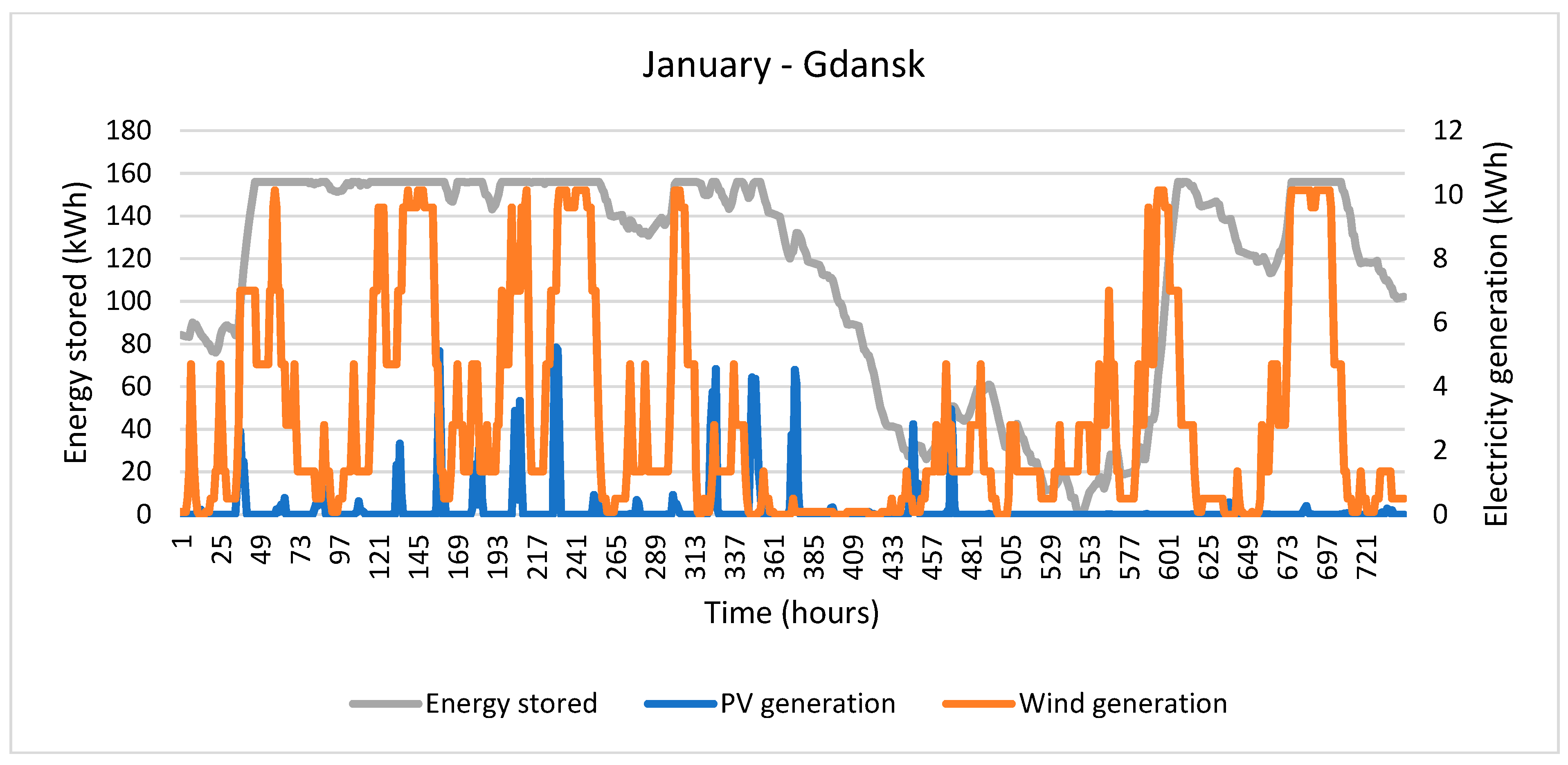

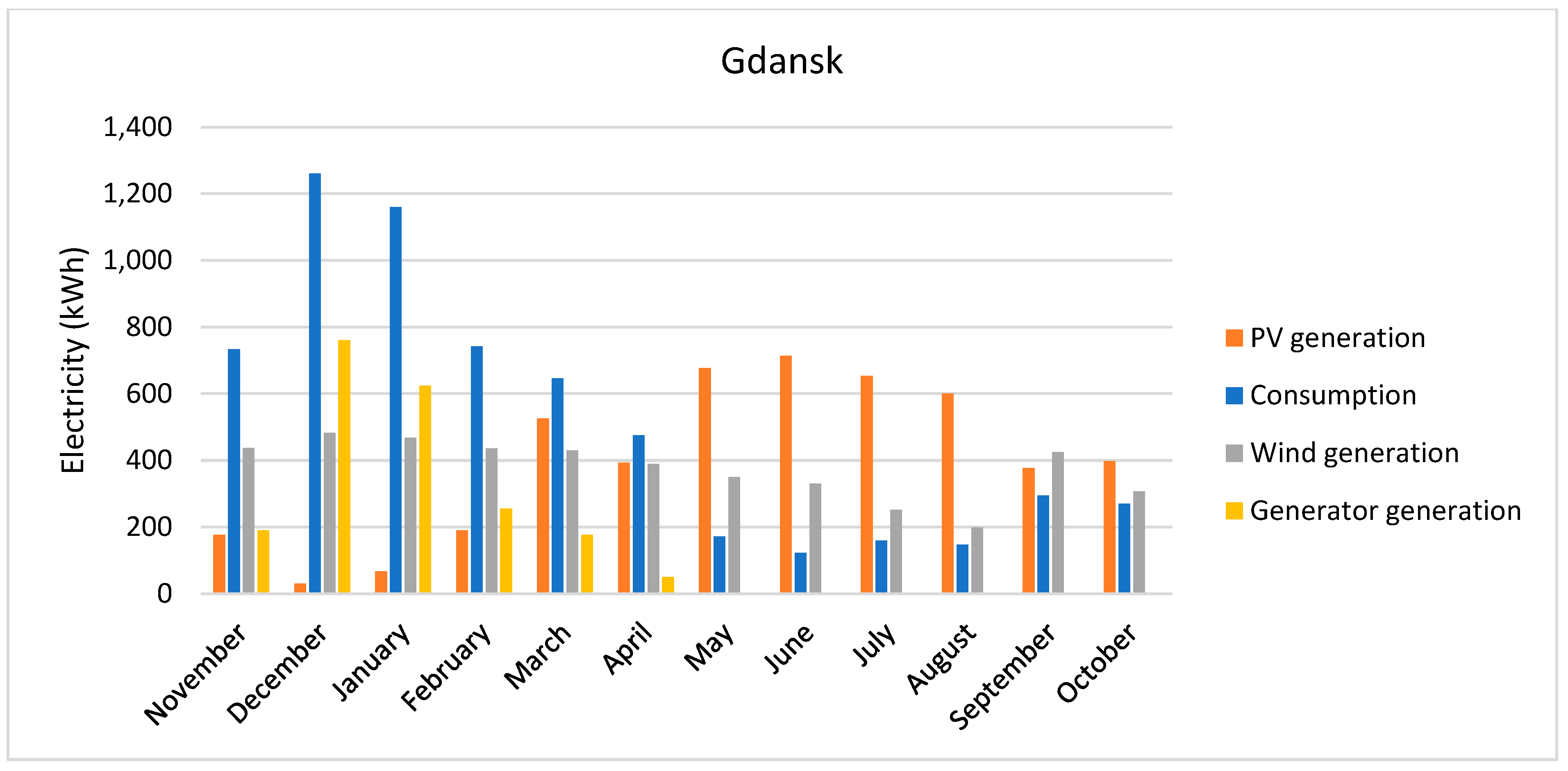
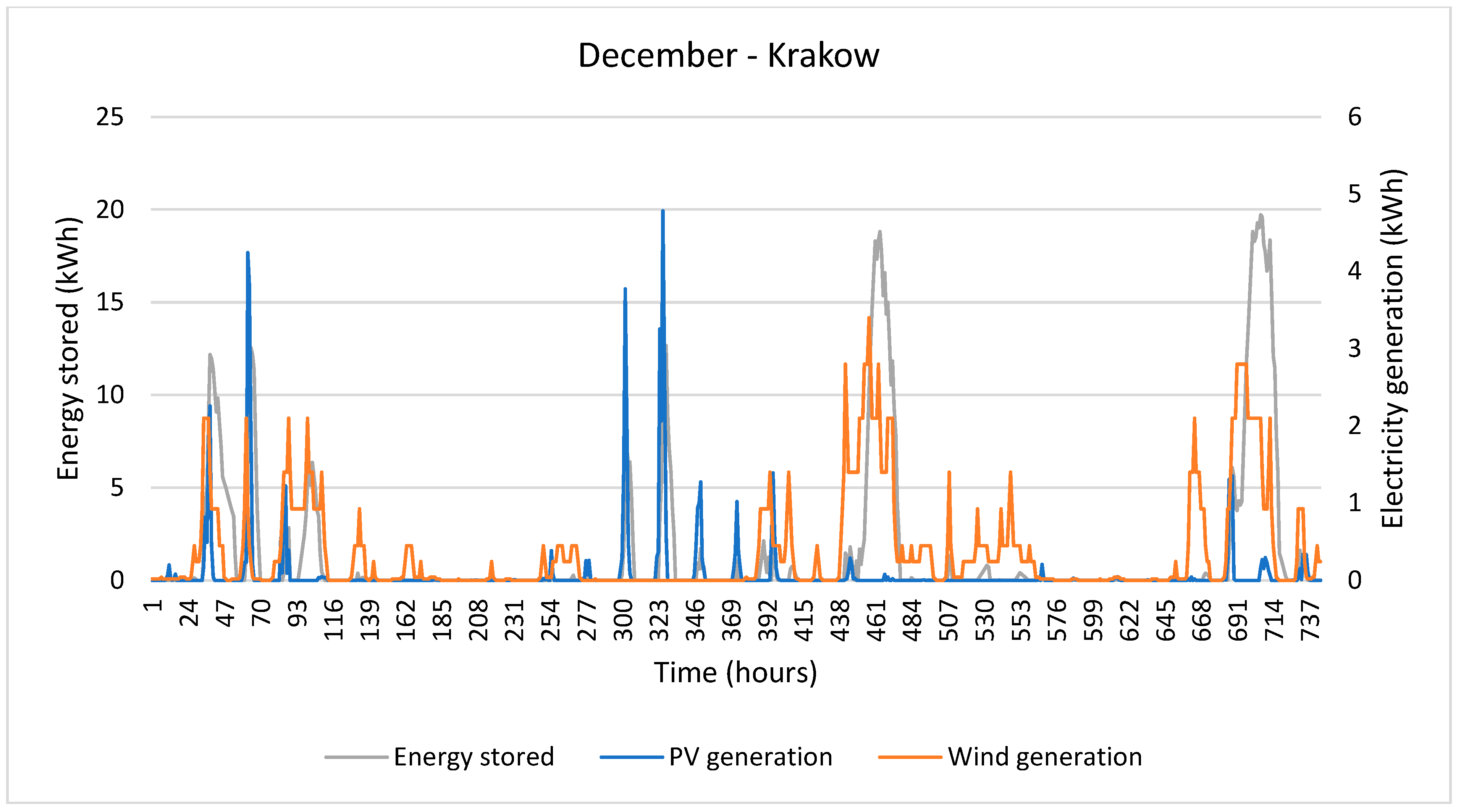
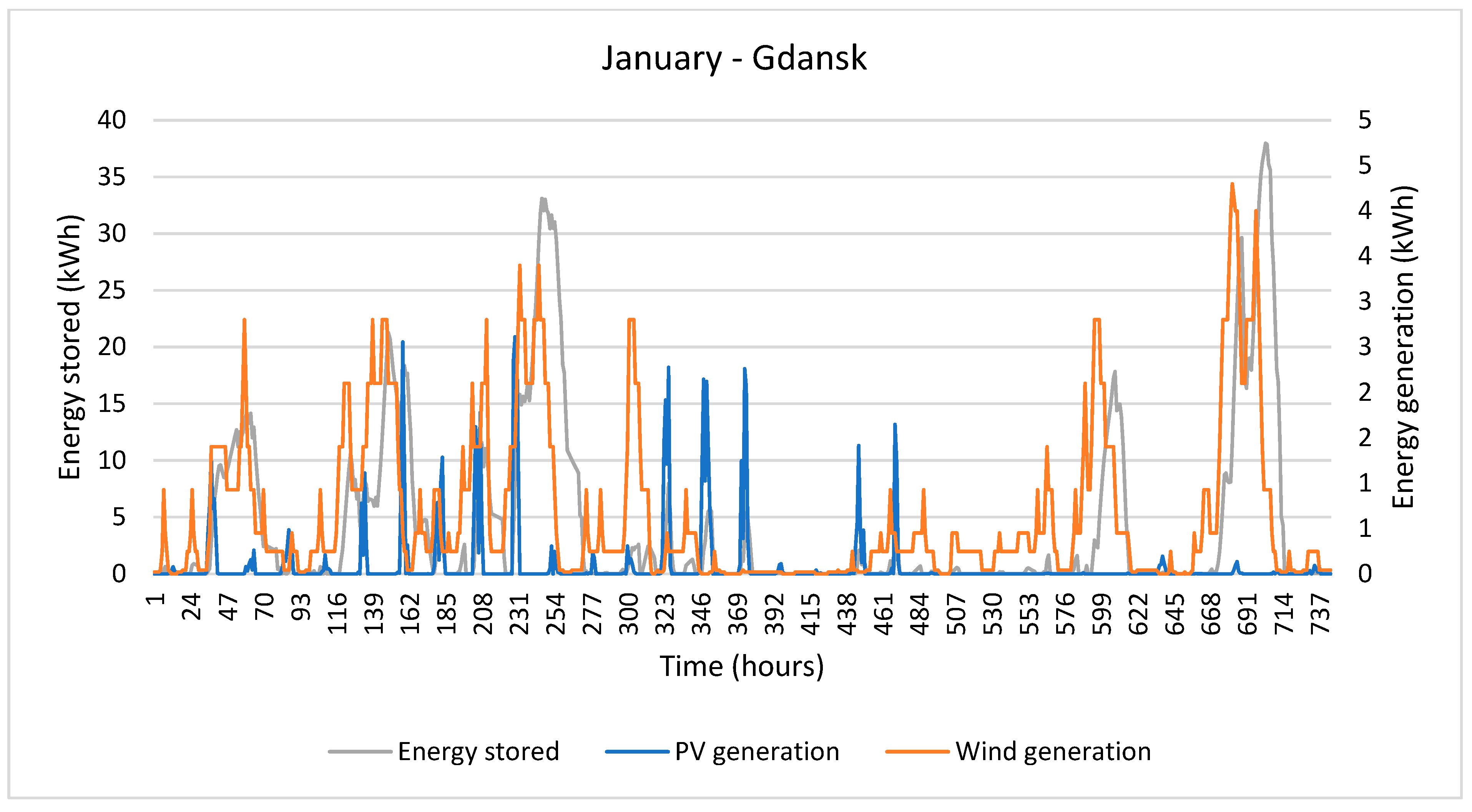
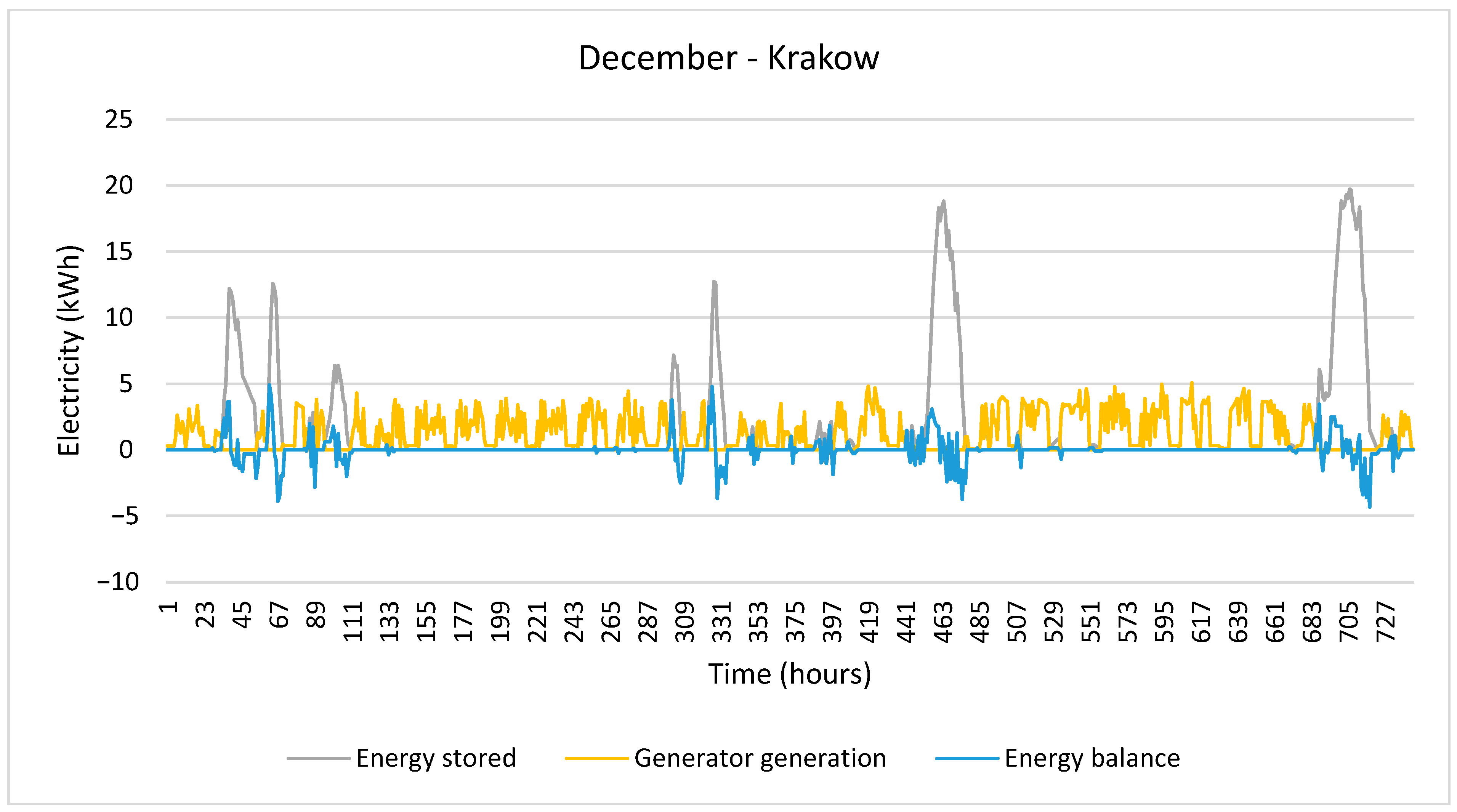
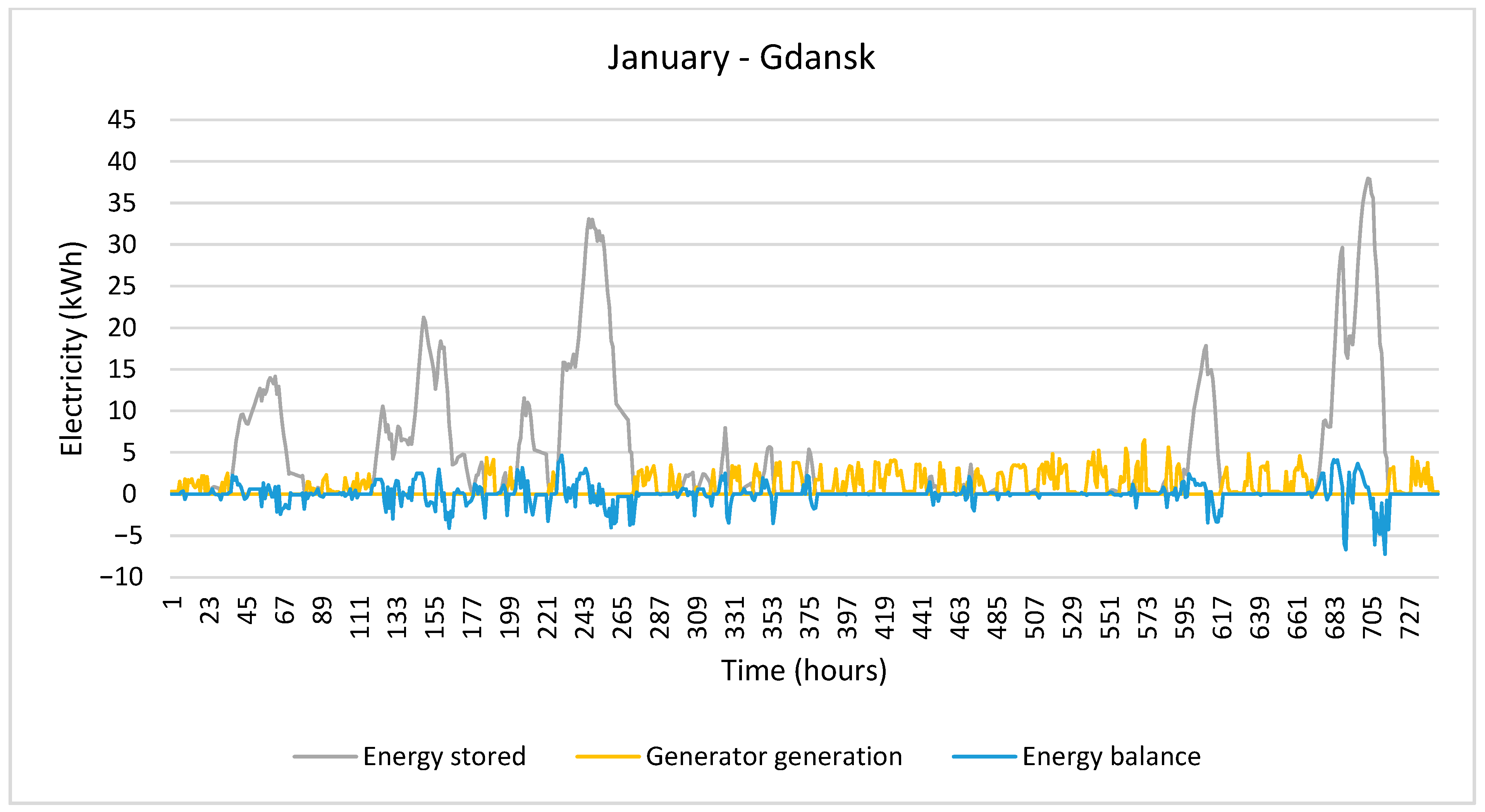
| WS | [m/s] | 0 | 1 | 2 | 3 | 4 | 5 | 6 | 7 | 8 | 9 |
| a | [kW] | 0 | 0 | 0.08 | 0.50 | 1.35 | 2.80 | 4.70 | 7.00 | 9.60 | 10.14 |
| WS | [m/s] | 0 | 1 | 2 | 3 | 4 | 5 | 6 | 7 | 8 | 9 | 10 | 11 | 12 | 13 |
| a | [kW] | 0 | 0 | 0.02 | 0.04 | 0.25 | 0.45 | 0.93 | 1.40 | 2.10 | 2.80 | 3.40 | 4.00 | 4.15 | 2.30 |
| Meteorological Station | Annual Average Wind Speed | Percentage of Year with Wind Speeds of Not Less Than 3 m/s |
|---|---|---|
| Krakow Balice | 2.5 m/s | 43.1% |
| Gdansk Port Północny | 4.1 m/s | 72.8% |
| Location | PV Power | Wind Power | Battery Capacity |
|---|---|---|---|
| Krakow Balice | 66 kWp | 10 kW | 411 kWh |
| Gdansk Port Północny | 10 kWp | 10 kW | 309 kWh |
| Location | PV Power | Wind Power | Battery Capacity |
|---|---|---|---|
| Krakow Balice | 43 kWp | 10 kW | 236 kWh |
| Gdansk Port Północny | 10 kWp | 10 kW | 156 kWh |
| Location | Total Energy Produced by the Generator in a Year | Maximum Hourly Energy Production from the Generator | Amount of Fuel Consumed Annually | Share of Energy from the Generator in Total Consumption |
|---|---|---|---|---|
| Krakow Balice | 2369.4 kWh | 8.7 kWh | 246.0 L | 38.3% |
| Gdansk Port Północny | 2058.8 kWh | 6.5 kWh | 213.8 L | 33.3% |
| Installation Component | Krakow: 10 kW PV System | Gdańsk: 5 kW PV System | Source |
|---|---|---|---|
| Heat Pump | 55,000 PLN | 55,000 PLN | [74] |
| PV system | 32,000 PLN | 21,000 PLN | [75] |
| 50 kWh Energy Storage | 120,000 PLN | 120,000 PLN | [76] |
| Wind Turbine | 50,000 PLN | 50,000 PLN | [77] |
| Pellet Boiler | 15,000 PLN | 15,000 PLN | [78] |
| Generator | 11,500 PLN | 11,500 PLN | [79] |
| Total costs | 283,500 PLN | 272,500 PLN |
| Location | Avoided Costs of Purchasing Electricity (PLN) | Pellets Cost (PLN) | Diesel Oil Cost (PLN) | Annual Savings (PLN) | Investment Payback Period (Years) |
|---|---|---|---|---|---|
| Kraków | 8342.9 PLN | 1660 PLN | 1476 PLN | 5206.9 PLN | 54.5 years |
| Gdańsk | 8342.9 PLN | 1660 PLN | 1284 PLN | 5398.9 PLN | 50.5 years |
Disclaimer/Publisher’s Note: The statements, opinions and data contained in all publications are solely those of the individual author(s) and contributor(s) and not of MDPI and/or the editor(s). MDPI and/or the editor(s) disclaim responsibility for any injury to people or property resulting from any ideas, methods, instructions or products referred to in the content. |
© 2025 by the authors. Licensee MDPI, Basel, Switzerland. This article is an open access article distributed under the terms and conditions of the Creative Commons Attribution (CC BY) license (https://creativecommons.org/licenses/by/4.0/).
Share and Cite
Jachimowski, A.; Luboń, W.; Michlowicz, Z.; Dawiec, D.; Wygoda, M.; Paprocki, M.; Wyczesany, P.; Pełka, G.; Jastrzębski, P. Renewable Energy Use for Conversion of Residential House into an Off-Grid Building—Case Study. Energies 2025, 18, 2301. https://doi.org/10.3390/en18092301
Jachimowski A, Luboń W, Michlowicz Z, Dawiec D, Wygoda M, Paprocki M, Wyczesany P, Pełka G, Jastrzębski P. Renewable Energy Use for Conversion of Residential House into an Off-Grid Building—Case Study. Energies. 2025; 18(9):2301. https://doi.org/10.3390/en18092301
Chicago/Turabian StyleJachimowski, Artur, Wojciech Luboń, Zofia Michlowicz, Dominika Dawiec, Mateusz Wygoda, Marcin Paprocki, Paweł Wyczesany, Grzegorz Pełka, and Paweł Jastrzębski. 2025. "Renewable Energy Use for Conversion of Residential House into an Off-Grid Building—Case Study" Energies 18, no. 9: 2301. https://doi.org/10.3390/en18092301
APA StyleJachimowski, A., Luboń, W., Michlowicz, Z., Dawiec, D., Wygoda, M., Paprocki, M., Wyczesany, P., Pełka, G., & Jastrzębski, P. (2025). Renewable Energy Use for Conversion of Residential House into an Off-Grid Building—Case Study. Energies, 18(9), 2301. https://doi.org/10.3390/en18092301







